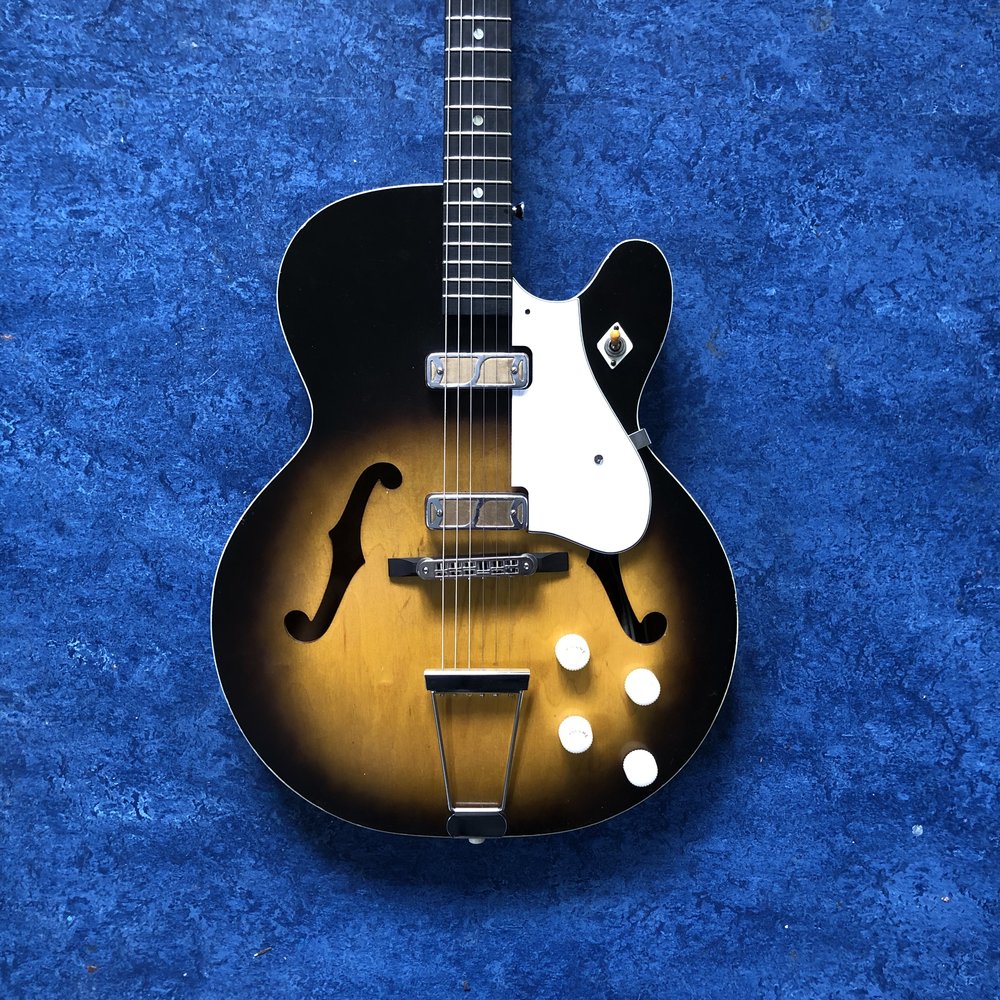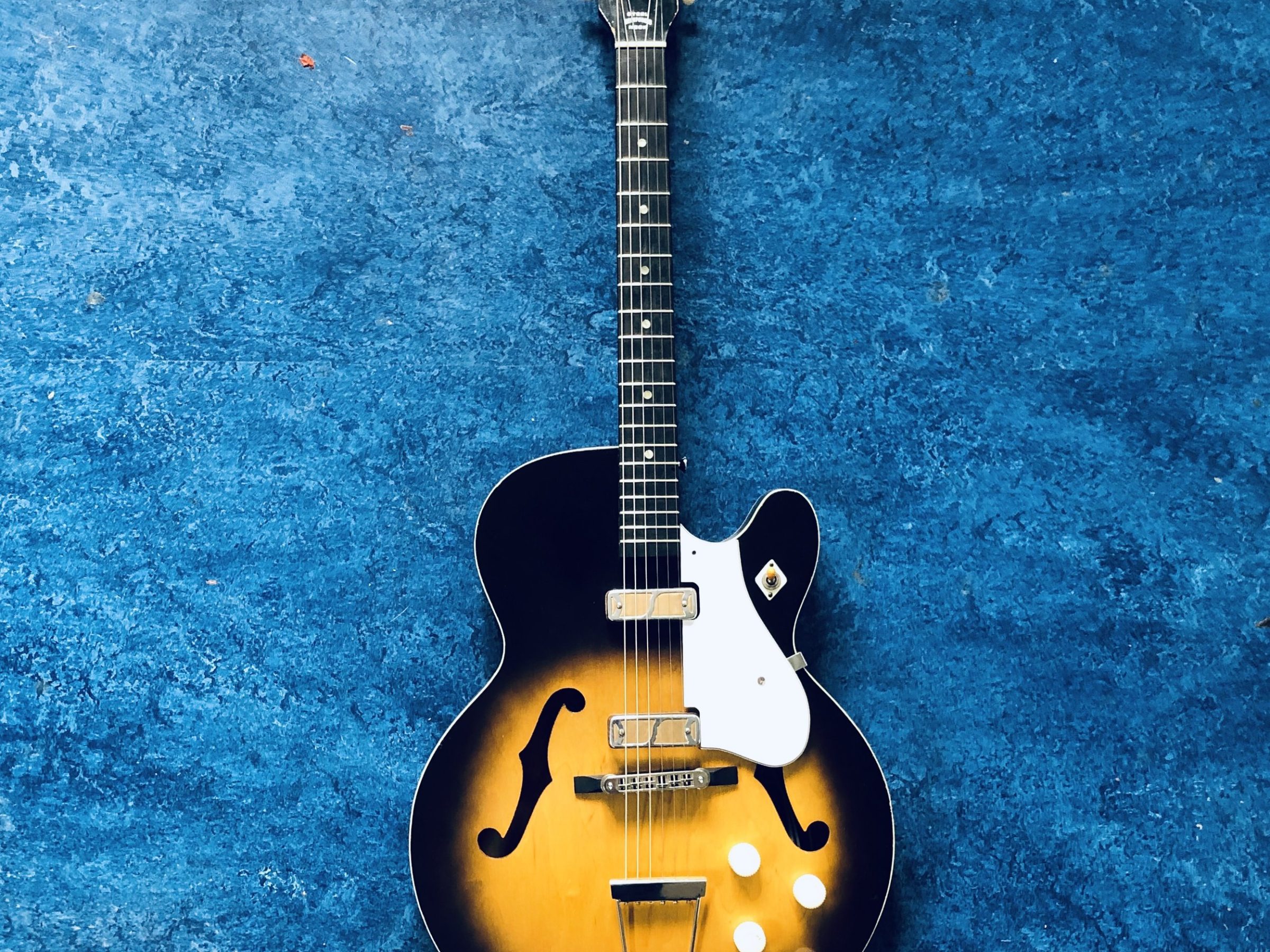The Harmony Rocket guitar has a rich history that dates back to the 1950s. Originally produced by the Harmony Company, the Rocket quickly gained popularity among musicians for its unique design and versatile sound. Today, the Harmony Rocket continues to be relevant in the music industry, with many artists still using it in their performances and recordings.
The Harmony Rocket was first introduced in 1958 as a semi-hollow body electric guitar. It featured a distinctive double-cutaway design, allowing for easy access to the higher frets. The guitar was known for its warm and rich tone, making it a favorite among jazz and blues players. Over the years, the Harmony Rocket has been used by notable musicians such as Dan Auerbach of The Black Keys and Annie Clark of St. Vincent.
Despite being over six decades old, the Harmony Rocket remains relevant today due to its timeless design and versatile sound. Its semi-hollow body construction gives it a unique resonance and sustain, making it suitable for a wide range of musical genres. Whether you’re playing jazz, blues, rock, or even indie music, the Harmony Rocket can deliver the sound you’re looking for.
Anatomy of the Harmony Rocket
To understand why the Harmony Rocket has such a distinct sound, it’s important to take a closer look at its components. The guitar features a semi-hollow body made of maple or mahogany, which contributes to its warm and resonant tone. The top of the body is typically made of laminated spruce or maple, adding to the guitar’s overall resonance.
The neck of the Harmony Rocket is usually made of maple or mahogany and is set into the body, providing stability and sustain. The fretboard is typically made of rosewood or ebony, offering a smooth playing surface for your fingers. The guitar also features two pickups – a bridge pickup and a neck pickup – which can be switched between using a three-way toggle switch. This allows you to achieve a wide range of tones, from bright and twangy to warm and mellow.
Choosing the Right Strings

When it comes to selecting strings for your Harmony Rocket, there are a few factors to consider. The gauge of the strings will greatly affect the playability and tone of the guitar. Lighter gauge strings, such as .009-.042, are easier to bend and play, making them ideal for lead guitarists. On the other hand, heavier gauge strings, such as .010-.046, offer more sustain and a fuller tone, making them suitable for rhythm guitarists.
It’s also important to consider the type of material used in the strings. Nickel-plated steel strings are the most common and offer a balanced tone with good durability. Pure nickel strings, on the other hand, have a warmer and vintage sound. Stainless steel strings provide a brighter tone and increased durability, but they can be harsh on your fingers.
Ultimately, the choice of strings for your Harmony Rocket will depend on your personal preference and playing style. Experiment with different gauges and materials to find the perfect set that suits your needs.
Exploring Tones and Sounds
One of the reasons why the Harmony Rocket is still relevant today is its wide tonal range. With its dual pickups and versatile switching options, you can achieve a variety of sounds with this guitar.
When both pickups are selected, you’ll get a balanced tone that works well for rhythm playing. This setting is great for strumming chords or playing clean arpeggios. By switching to the bridge pickup, you’ll get a brighter and twangier sound that’s perfect for country or rockabilly music. On the other hand, using only the neck pickup will give you a warmer and mellower tone that’s ideal for jazz or blues.
To further shape your tone, you can adjust the volume and tone controls on the guitar. Rolling back the tone control will give you a darker and smoother sound, while increasing the volume will add more bite and presence to your tone.
Playing Clean and Accurate Chords
To achieve clean and accurate chords on the Harmony Rocket, proper hand positioning is crucial. Start by placing your thumb behind the neck of the guitar, allowing your fingers to have a good grip on the fretboard. Make sure your fingers are pressing down on the strings with enough pressure to produce a clear sound, but not too much that it causes unnecessary tension in your hand.
When playing chords, it’s important to keep your fingers as close to the frets as possible. This will help prevent any unwanted buzzing or muted notes. Practice transitioning between chords smoothly and accurately, paying attention to any areas that may need improvement.
Another tip for clean chord playing is to use the tips of your fingers to press down on the strings. This will ensure that you’re only pressing down on the necessary strings and not accidentally muting any adjacent strings.
Achieving a Smooth Vibrato
Vibrato is a technique used to add expression and emotion to your playing. It involves bending the pitch of a note slightly up and down, creating a subtle wavering effect. To achieve a smooth and consistent vibrato on the Harmony Rocket, start by placing your thumb behind the neck for support.
Using your fretting hand, bend the string slightly up and down while maintaining a steady rhythm. The key is to be controlled and deliberate with your movements, rather than rushing or overdoing it. Practice this technique slowly at first, gradually increasing the speed as you become more comfortable.
Experiment with different widths and speeds of vibrato to find what works best for you and the style of music you’re playing. Remember that vibrato is a personal expression, so don’t be afraid to experiment and develop your own unique style.
Using the Tremolo Arm
The Harmony Rocket is equipped with a tremolo arm, also known as a whammy bar or vibrato arm. This feature allows you to create unique pitch-bending effects by manipulating the tension of the strings.
To use the tremolo arm, start by resting your palm on the bridge of the guitar to stabilize it. With your other hand, grab the tremolo arm and gently push it down towards the body of the guitar. This will lower the pitch of the notes you’re playing. To raise the pitch, pull the tremolo arm up away from the body.
Experiment with different degrees of pitch bending and combine it with other techniques such as vibrato to create interesting and expressive sounds. The tremolo arm can be a powerful tool for adding dynamics and emotion to your playing.
Single Coil vs. Humbucker Pickups
The Harmony Rocket is available with both single coil and humbucker pickups, each offering a distinct sound and character.
Single coil pickups are known for their bright and clear tone, with a pronounced midrange and tight bass response. They have a slightly lower output compared to humbuckers, which can result in a cleaner and more articulate sound. Single coil pickups are commonly used in genres such as blues, country, and funk.
Humbucker pickups, on the other hand, have a thicker and warmer tone with more sustain. They are made up of two coils that are wired in series, which helps to cancel out any unwanted noise or hum. Humbuckers have a higher output compared to single coils, making them suitable for genres such as rock, metal, and jazz.
To make the most of your Harmony Rocket’s pickups, experiment with different pickup combinations and adjust the tone controls to find your desired sound.
Advanced Techniques for Shredding and Soloing
If you’re looking to take your playing to the next level, there are several advanced techniques that you can apply to the Harmony Rocket.
One technique is alternate picking, which involves using both upstrokes and downstrokes to play notes. This technique allows for faster and more precise playing, making it ideal for shredding and soloing. Practice playing scales and arpeggios using alternate picking to improve your speed and accuracy.
Another advanced technique is sweep picking, which involves playing multiple notes on adjacent strings with a single motion of the pick. This technique creates a smooth and fluid sound, perfect for fast and intricate solos. Start by practicing simple arpeggio shapes and gradually increase the difficulty as you become more comfortable.
Other advanced techniques to explore include string bending, tapping, and legato playing. These techniques can add depth and complexity to your solos, allowing you to create unique and expressive melodies.
Incorporating the Harmony Rocket into Your Playing Style

To make the most of your Harmony Rocket, it’s important to incorporate it into your playing style. Experiment with different genres and styles of music to see how the guitar responds.
For jazz and blues players, the warm and mellow tone of the Harmony Rocket is perfect for creating smooth and soulful melodies. Experiment with different chord voicings and scales to add depth and complexity to your playing.
Rock and indie musicians can take advantage of the guitar’s versatility by exploring different pickup combinations and effects pedals. The semi-hollow body construction of the Harmony Rocket provides a unique resonance that can add character to your sound.
No matter what style of music you play, the Harmony Rocket can be a valuable addition to your arsenal. Its timeless design, versatile sound, and rich history make it a guitar that will continue to be relevant for years to come.
Conclusion:
The Harmony Rocket guitar has a long history that dates back to the 1950s. Despite its age, it remains relevant today due to its unique design and versatile sound. The guitar’s anatomy, including its semi-hollow body, neck, and pickups, contribute to its distinct tone. When choosing strings for the Harmony Rocket, factors such as gauge and material should be considered. The guitar offers a wide tonal range, allowing for different sounds to be achieved. Proper hand positioning is important for playing clean and accurate chords on the Harmony Rocket. Techniques such as vibrato and the use of the tremolo arm can add expression and unique effects to your playing. The guitar is available with both single coil and humbucker pickups, each offering a different sound. Advanced techniques such as alternate picking and sweep picking can be applied to the Harmony Rocket for shredding and soloing. Finally, incorporating the Harmony Rocket into your playing style can help you make the most of its unique features.
